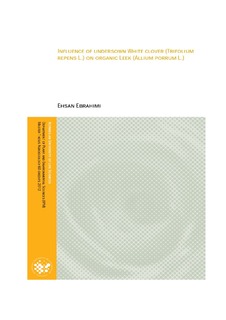| dc.contributor.author | Ebrahimi, Ehsan | |
| dc.date.accessioned | 2013-03-20T13:09:13Z | |
| dc.date.available | 2013-03-20T13:09:13Z | |
| dc.date.copyright | 2012 | |
| dc.date.issued | 2013-03-20 | |
| dc.identifier.uri | http://hdl.handle.net/11250/189545 | |
| dc.description.abstract | Leek fields with open canopy are unprotected to weed suppression and nutrient leaching
during their growing period. Intercropping can be an alternative way to conventional production on
bare soil or as a mono-crop system. Intercrop has positive effect on weed management and
nutrient support for main plant and even further plant in field. Respectively, this experiment has
been designed based on undersown (US) management to increase sustainability based on
agroecological rules. So the experiment concocted to evaluate the influence of US management in
combination of different treatments with early sowing of clover as US simultaneously leek and late
sowing of clover 48 days after transplanting of leek in the field and also cutting or not cutting of
clover in treatments with clover and in some treatments leek transplanted on bare soil and in some
treatments US have sowed without leek.
The yield attributes like diameter and dry matter (DM) were influenced by the date of
sowing of US and also cutting management of clover. Treatments with late US as well as treatment
without US but with hand weeding (HW) show the best diameter in both harvest which indicate a
positive relation between field density and diameter size. These trends were followed by total DM
per hectare in the first harvest but in the second harvest the differences between treatments were
not significant. The results illustrated that DM% was not affected by field density. In this case,
treatments which spend more time with US indicates better DM% compared with others. Although
these differences were not significant in first harvest but in second harvest treatment with early US
and with cut displayed better DM% and had positive relation with treatments with early US and
without cut and also with treatment without US but without HW. Application of US and US
management didn’t have significant effect on leek height and also nutrient content of DM.
This experiment was invaded by animals during winter. After monitoring of field it is
understood that destruction of field has a method and it is believed that animals have special trend
to eat leeks. Analysis of leek size indicates that treatments with early US were destroyed more
than other treatments. In other words, animals preferred to eat the plots were clover were existing
in for longer time. It is thought that animal has priority for eating the leeks as well. Treatments with
more density were their first option for eating and then they have continued with other plots. | no_NO |
| dc.language.iso | eng | no_NO |
| dc.publisher | Norwegian University of Life Sciences, Ås | |
| dc.title | Influence of undersown white clover (Trifolium repens L.) on organic Leek (Allium Porrum L.) | no_NO |
| dc.type | Master thesis | no_NO |
| dc.subject.nsi | VDP::Agriculture and fishery disciplines: 900::Agriculture disciplines: 910::Plant breeding, horticulture, plant protection, plant pathology: 911 | no_NO |
| dc.source.pagenumber | 46 | no_NO |
